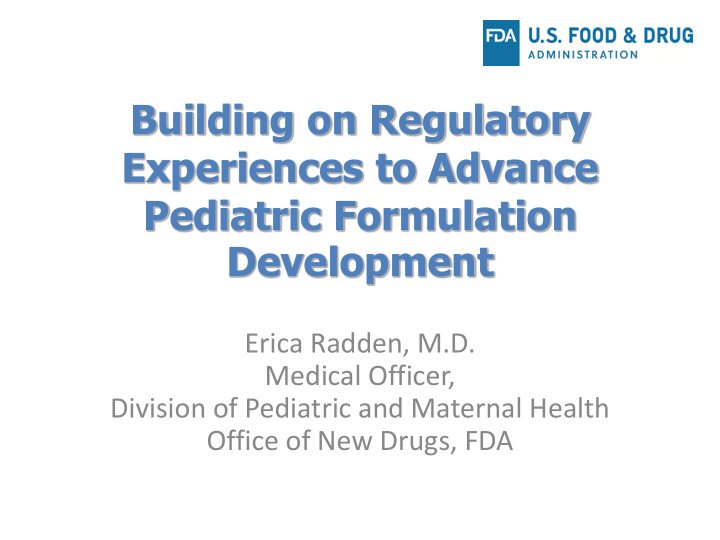



Building on Regulatory Experiences to Advance Pediatric Formulation Development Erica Radden, M.D. Medical Officer, Division of Pediatric and Maternal Health Office of New Drugs, FDA
2 Disclosure Statement • I have no financial relationships to disclose relating to this presentation • The views expressed in this talk represent my opinions and do not necessarily represent the views of FDA 2
Overview • Overview of US pediatric regulatory framework • Considerations in the approach to determine if a formulation is age-appropriate • Current formulations approved for pediatric patients • Lessons learned 3
Pediatric Regulatory Framework • Best Pharmaceuticals for Children Act (BPCA) – Provides a financial incentive to companies to voluntarily conduct pediatric studies • Pediatric Research Equity Act (PREA) – requires companies to assess safety and effectiveness of certain products in pediatric patients 4
Pediatric Regulatory Framework PREA BPCA Must conduct necessary studies using an age-appropriate formulation for each proposed age group. If there is not an age-appropriate formulation available, the Sponsor must develop and test one Partial waiver available if reasonable If formulation development attempts to produce a pediatric formulation fails, the Sponsor must necessary for that age group have failed; document attempts to develop documentation from the applicant will be and reasons for failure of posted on the FDA Web site formulation An initial Pediatric Study Plan must be submitted shortly after End of Phase 2 meeting, including a section outlining Pediatric Formulation Development 5
Pediatric Formulation Development: iPSP Content • Details about pediatric-specific formulations being developed and the applicable populations • If the current formulation is not suitable for all proposed age groups, provide the plan for development of an age-appropriate formulation – Type (capsules, tablet, infusion, device) – Excipients (safety) – Use Pattern (e.g., relative to meals, chronic use) – Acceptability relative to age (e.g., size, swallowability, palatability, strength, etc.) – Ease of administration – Measurement – Stability 6
General Approach to Assessment of Age-Appropriate Formulation Multidisciplinary evaluation • Risk/benefit assessment of characteristics of the formulation and • physical/anatomical features of the proposed population on the efficacy/safety/appropriateness of the formulation Potential Questions • – Is the formulation acceptable based on the type (e.g., tablet size, volume of liquid) and intended use? – Does the strength or concentration make sense for the anticipated dose range needed? – Any issues for absorption/delivery or safety based on route? – For oral formulations, are there any palatability or swallowability issues (e.g., bitter taste, choking risk)? – For devices, is there need for human factors validation testing? – For injectables, will there be significant wastage? Needle size issues? 7
FDA Regulatory Gaps No FDA guidance on safe tablet size or swallowability assessments. o FDA guidances are available on solid oral dosage forms regarding CMC and biopharmaceutics (e.g., dissolution and bioequivalence) and others that focus on formulation development (e.g., pediatric HIV). o EMA Guideline on Pharmaceutical Development of Medicines for Paediatric Use and published literature. Not always able to require development of age- appropriate formulations if PREA or BPCA is not applicable to the product. 8
Products with Waivers due to Formulation Issues • Capsule/tablet – Safety concern at doses with similar exposure to adults, suboptimal efficacy at lower doses – <6 months of age • Nasal aerosol spray – Inadequate fit of nasal actuator tip – 2-5 years of age • Extended/delayed-release tablet – Unable to simulate release profile/stability issues – <6 years of age 9
Approved Pediatric Formulations • Of the 792 products with pediatric labeling changes through May 2019, 53 have included a formulation developed for pediatrics including: Oral suspensions/solution Lower strength tablets/solution; Concentrated oral suspension Oral disintegrating tablets/oral soluble film Chewable tablets/ Chewable bar 3-D printed tablets Nasal spray/inhaler Multiparticulates (oral powder/ oral granules/mini- tablets/sprinkle capsules) Delayed and extended release tablets and capsules 10
Summary The overall goal of legislation is to have safe and effective drugs approved in relevant age groups. A range of formulations have been successfully developed. The future goal is to incorporate formulation planning for pediatric populations at the onset of product development to provide a formulation(s) that are can be safely and effectively administered to the full population that will be studied. Better understand regulatory and industry challenges in adopting this approach and overall challenges to innovation. 11
Thank you 12
Acknowledgements Thanks to Debbie Avant, R.Ph., Mona Khurana, M.D., and Hari Cheryl Sachs, M.D. for their assistance in preparation for this presentation
Recommend
More recommend